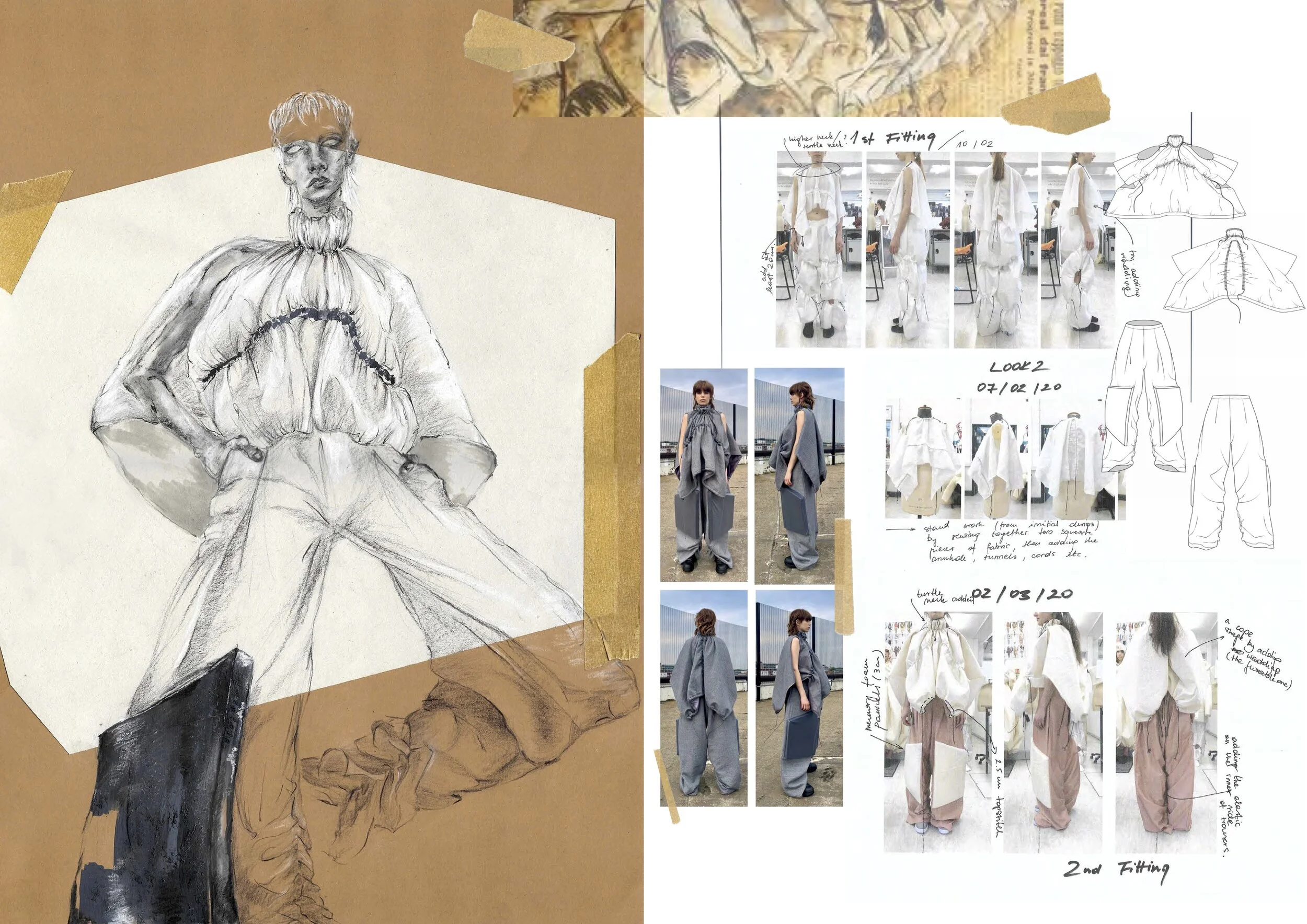The Digital Fashion Portfolio Award will be given to a well-executed, contemporary and professionally presented digital fashion portfolio that demonstrates an individual and creative identity, whilst communicating a thinking process from the concept ideas, through their development to the final presentation and layout. Meet the nominees!
Alice Riley, Nottingham Trent University
To finish a collection through a pandemic meant adapting some previous ideas to fit to the facilities and equipment available at home. This resulted in more of a mix media approach, focusing on bringing materials previous explored in the initial research stages, such as the industrial and woven surface qualities. As well as using more hand methods such as macramé and hand knitting, creating more diversified surfaces through the scale and overall construction. By combining these methods with some of the previous panels constructed at university it created a strong contrast and relationship back to the initial collection research. This also allowed reflection on previous patterns and mark making, to then be translated into domestic structures, creating more of a pattern and colour focus. These patterns and surface qualities were played on through combining domestic patterns with the hand knitting and macramé techniques with industrial materials. Which allowed there to be a variety of soft and harsh qualities, reflecting the primary research and the layers of architectural materials. Overall, the collection adapted its methods and way of working to fit the home facilities. Yet, creating the same structural silhouettes desired at the start of the year but now repurposing materials.
Ana-Maria Ciocirlan, Birmingham City University
Alejandro Jodorovsky’s The Holy Mountain inspired this story. As well as the filmmaker’s profound study of the tarot revealed in his book, ‘The Way of the Tarot, the Spiritual Teacher in the Cards’ as both played an important role into the designer’s creative and spiritual development. The design direction looks towards a mix of archetypes that are highlighted by the characters int he film, inspiring the silhouettes of the garments as well as the colour palette. The Tarot de Marsielle card deck inspired the print, as they become a key element in it’s development. As some of the cards from the major arcana were redesigned to express the designer’s reinterpretation of their meaning.
Caolum McCabe, Arts University Bournemouth
My Collection “Mother Ireland” casts a glance over Irish history when England took over Ireland during the Elizabethan reconquest. Ireland lost all sense of culture, language and identity. The only way Ireland could defend itself as a nation in the latter years preceding independence was to personify its women through myths and legends. Woman was to be seen not heard. Often lamenting her rape, the land was seen as an object to be repossessed bby man, constructing gender norms. Each garment is a celebration of the strength of Irish women, namely his mother’s. Their spirit is embodied without, such as in the insipid green hues of his grandmother’s dress which has influences by natural dye processes, or the love letters his mother wrote as a child which have become a print and have been reversed so that they read from him to her. The collection is an ode to them.
Chloe Newman, University for the Creative Arts Rochester
My concept is inspired by the series and real life events of the Chernobyl nuclear disaster, that occurred in 1986. This accident took place at the No 4 nuclear reactor in the Chernobyl Nuclear Power Plant, near the city of Pripyat. It is considered the worst nuclear disaster in history. The Babushkas are a group of old women, that have clung to their ancestral homeland inside the radioactive “Exclusion Zone” and refused to leave. The decision was made that because these women were old, they were allowed to stay, due to them dying of old age before the radiation could affect them. The Babushka’s homes are extremely depressing and run down, however, hand painted floral cloths and cutlery were decorated around the interior. These are called Petrykwka decorative paintings and were the inspiration behind my feminine touch.
Chloe Winnett, Cardiff School of Art & Design
‘Forecast’ is a sustainably focused collection inspired by how consumerism has impacted our world creating our Anthropocene Era. Aiming to visually challenge the relationship between consumer and clothing by creating a (possible future) post apocalyptic world. Merging the need for survival and consumer behaviour, asking for a slower more meaningful circular cycle of fashion. Inspired by historical unorthodox survival clothing in history from the World Wars (1914-18, 1939-45), to the Chernobyl disaster of 1986 and the most recent COVID-19 virus of 2020. Fabrics are up cycled using waste army combat wear brought home by soldiers after tour. Textiles manipulation has been applied to old army jumpers in order to create the camouflage illusion to be used as a disguise tactic to hide and survive. Each look is complete with a tailored headwear that has been used for survival wear in the past or present, displaying the evolution of survival wear clothing in history.
Emily Tonge, Manchester Metropolitan University
During my second year Contextual Practise studies, ‘Art and Architecture’, I learnt of the 1950s ‘New towns’ - a phenomenon of the post-war housing boom. When the government began creating these ‘New towns’ for families in cities to migrate to, there was little consideration for women. The lack of infrastructure ensnared women in a life of domesticity; trapped within their own homes, while their husbands were away at work. As a starting point, I thought this reality which faced these women could form the basis of a modern-day horror film.
I began to build a dystopian world where the 1950s New Towns still exist, taking inspiration from the 1970s installation Womanhouse led by Judy Chicago, movies from the 1950/60s and vintage interiors and clothing. Many of the silhouettes I design come from stand work with generic garments, which have been manipulated or deconstructed on the stand. I select the garments based on the concept I am working on. For my final collection, it has focused on the 1950s and 60s, so I sourced a variety of garments from this period to experiment with.
Gianluca Rondelli, Northumbria University
“Everything has already been done before.” It’s time to not look in the past for inspiration for new designs, it’s time to ultimately make it up. Rewrite the historybooks and start fresh. This is my design philosophy, pushing into the research of new environments made of “what ifs” influenced by hyper climate change and other significant world changes that could occur. Asking out of the box questions of “what ifs” in a dystopian or utopian scenario will inform innovation through problem solving. This will start the design process: asking questions of “how do we overcome this problem with garment design?” A Mythical Creature is attacking you. How can your garment change to defend, attach or adapt to the environment?...
Konstancja Przybylska, University for the Creative Arts Epsom
While preparing for this competition I decided to list the characteristics of futurism: geometrical shapes, abstract patterns, movement, dynamics. But then, I realised that futurism is nothing less than a way of seeing the world in a new, fresh and innovative way.
The genesis of this project goes back to Umberto Boccioni’s exhibition of 3D reconstructed sculptures in the Estorick Collection. It is my personal interpretation of futurism, which I executed through abstract forms achieved from combining drape with sharp geometrical shapes. The inventive use of recycled memory foam allowed me to build a range of sculpture- like garments inspired by seeing the past through the lenses of the digital age and technology. This is where the fabric story comes from; the tweeds and herringbones reference the more traditional fabrics that Futurists used to wear at the beginning of the 20th century. Combining them with PVC or nylon allowed for a new condition; a condition between the past and the future, to occur.
Lucy Saunders, Kingston University London
My final year collection aims to answer one main question: how can i bring harmony to two concepts that don’t necessarily fit together at first sight? The unity stemming from the contrast of old and new, and the functional and refined design, is the canvas of my style. The overarching theme of my collection also reflects three main sources of inspiration: sustainability, work experience and my childhood living by the sea. The collection was the pinnacle of my BA Fashion degree and my most challenging accomplishment to date.
Lucy Walker-Cox, Edinburgh College of Art
My collection takes inspiration from womxn of the past/present who have thrived against the odds, and gives them an imagined future where they are safe, empowered, celebrated. Looking at my own Scottish heritage and the womxn in my family, I was inspired by the combination of technology and traditional craft that is used in so many of the industries in the highlands - from whiskey to shortbread. I wanted to bring this idea of innovating with craft to the forefront of the collection, particularly through my knitting. I want my collection to celebrate and empower womxn and to be as inclusive as possible.
Megan Andrews, Northumbria University
A self-contained landscape of white, the striking marble quarries of Carrara, Italy, are their own isolated world: severe, bizarre and beautiful. My final major project is centered around the view at the precipice, dynamically and conceptually exploring various visual, cultural and historical concepts, to produce a diverse outcome of menswear garments. At the core, my collection is deeply driven by texture, fabric, colour, detail and silhouette, collectively capturing an air of careful simplicity and sensibility.













